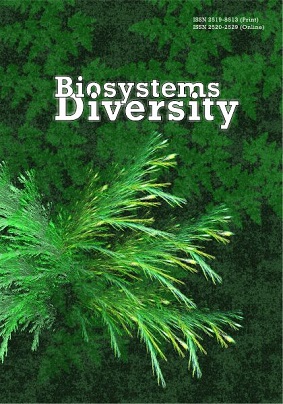Are Heteroptera communities able to be bioindicators of urban environments?
Are Heteroptera communities able to be bioindicators of urban environments?
Author(s): O. M. Kunakh, I. O. FedyaySubject(s): Physical Geopgraphy, Rural and urban sociology, Environmental interactions
Published by: Дніпропетровський національний університет імені Олеся Гончара
Keywords: Homoptera; biodiversity; ecological groups; metropolis; phytoindicatory assessment; bioindicators;
Summary/Abstract: The Heteroptera is a group of animals associated with the vegetation cover. The conducted analysis indicates that groups of heteropterans in the urban environment have a pattern of reaction to the environmental factors, determined using the phytoindication method. In the study, we considered the following hypotheses: 1) phytoindicational assessments of ecological factors may explain the patterns of variation of the groups of heteropterans; 2) among Heteroptera species, comparatively homogenous ecological groups could be distinguished which are characterized by similar character of response to the effect of certain environmental factors; 3)these groups could be used for bioindication of the conditions of environment in urban ecosystems. Stationary collection of heteropterans was performed during three years from May to October of 2017–2019 on six plots in Kharkiv. The article describes factors which affect the structure of groups of Heteroptera within the ecosystem of the large city and assess the bioindication possibilities. The data presented in the article, as well as the conclusions drawn, are to a large extent associated with stenotopic species, most of which could be used as bioindicators of the condition of one or another biocenosis. According to the results of a taxonomical survey in the territory of Kharkiv, 180 species of Heteroptera were found, belonging to 120 genera and 17 families. The highest species diversity was seen for the family Miridae, accounting for 50 species (27.0% of the total number of counted species). Fewer species were identified as the representatives of families Lygaeidae – 46 species (24.9%) and Pentatomidae – 23 (12.4%). Family Rhopalidae was represented by 11 species (5.9%). Nabidae and Tingidae – 10 species each (5.4%). Families Coreidae – 8 (4.3%), Cydnidae and Scutelleridae – 4 species each (2.2%), Anthocoridae – 3 (1.6%). The families Berytidae, Piesmatidae, Pyrrhocoridae and Reduviidae were represented by only 2 species each (1.1%). Families Acanthosomatidae, Alydidae and Aradidae were represented by 1 species each, in total accounting for 1.5%. The reasonably high level of species and ecological diversities of Heteroptera in the territory of the city allows them to be used in bioindication studies. We determined comparatively homogenous ecological groups of heteropterans which have a similar pattern of response to the impact of certain environmental factors. The study demonstrates that phytoindicatory assessments of the ecological factors can explain the patterns of variation in groups of heteropterans, We determined the factors which have effects on the structure of the group of heteropterans within the metropolitan ecosystem. The level of their effect on groups of heteropterans within the city is different. The most influential were light and humidity. Comparison of potential and realized projections of ecological space allows us, to a certain extent, to generate hypotheses about the orientations of transformation of the group heteropterans.
Journal: Biosystems Diversity
- Issue Year: 28/2020
- Issue No: 2
- Page Range: 195-202
- Page Count: 8
- Language: English

